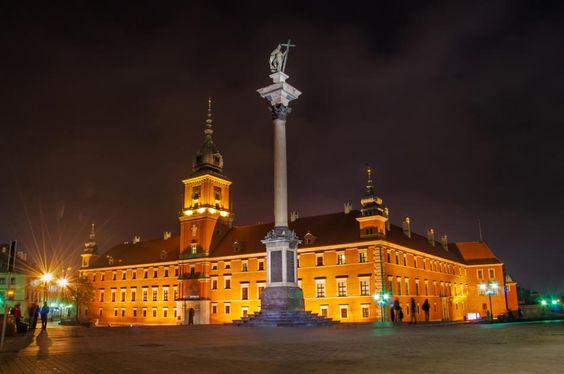The Royal Castle in Warsaw, known as „Zamek Królewski” in Polish, is a national historical monument and a state museum that once served as the official royal residence of several Polish monarchs. The castle, located in Castle Square at the entrance to Warsaw’s Old Town, houses a significant collection of Polish and European art.
The castle’s history is deeply intertwined with notable events in Poland’s history. The Constitution of 3 May 1791, the first of its kind in Europe and the world’s second-oldest codified national constitution, was drafted within its walls. The castle was redesigned in a neoclassical style following the partitions of Poland and served as the seat of the Polish head of state and president during the Second Polish Republic (1918–1939).
However, the Second World War brought complete destruction to the building. In September 1939, it was targeted and ignited by Luftwaffe fighter aircraft, and then detonated by the Nazis after the failed Warsaw Uprising in 1944. The surviving wall fragments, cellars, the adjacent Copper-Roof Palace, and the Kubicki Arcades were registered as historical monuments in 1965. Reconstruction took place between 1971 and 1984, restoring the castle to its original 17th-century appearance. In 1980, the Royal Castle and surrounding Old Town were designated a UNESCO World Heritage Site.
Today, the Royal Castle is the second most visited art museum in Poland, attracting over 1.75 million visitors in 2022. Its rich history and cultural significance make it a symbol of Warsaw and a testament to Poland’s resilience and dedication to preserving its heritage.

Article
The Royal Castle in Warsaw, a symbol of the Polish capital and a testament to its rich history and culture, stands proudly in Castle Square, marking the entrance to the city’s Old Town. Once the official residence of several Polish monarchs, the castle now serves as a state museum and a national historical monument, housing a significant collection of Polish and European art.
The castle’s history is marked by notable events that have shaped Poland’s destiny. The Constitution of 3 May 1791, the first of its kind in Europe and the world’s second-oldest codified national constitution, was drafted within these walls. Following the partitions of Poland, the castle underwent a transformation, adopting a neoclassical style. During the Second Polish Republic (1918–1939), it served as the seat of the Polish head of state and president.
However, the Second World War brought devastation to the castle. In September 1939, it was targeted and ignited by Luftwaffe fighter aircraft, and then detonated by the Nazis after the failed Warsaw Uprising in 1944. The surviving wall fragments, cellars, the adjacent Copper-Roof Palace, and the Kubicki Arcades were registered as historical monuments in 1965. Between 1971 and 1984, the castle underwent a reconstruction process, regaining its original 17th-century appearance. In 1980, the Royal Castle and the surrounding Old Town were designated a UNESCO World Heritage Site.
Today, the Royal Castle is the second most visited art museum in Poland, attracting over 1.75 million visitors in 2022. Its rich history and cultural significance make it a symbol of Warsaw and a testament to Poland’s resilience and dedication to preserving its heritage.
The castle’s history dates back to the 14th century when the first Castle Tower was constructed, and the fortified complex was initially used as the residence of the Masovian dukes. In the early 1600s, it was designated to replace Wawel Castle in Kraków as the seat of the King, Parliament (Chamber of Deputies and Senate), and the Polish–Lithuanian Commonwealth. The medieval Gothic structure was remodeled into Italian mannerism by architects Matteo Castelli and Giovanni Battista Trevano. The Baroque easternmost wing was designed by Gaetano Chiaveri and completed in 1747.
The castle’s history is marked by notable events that have shaped Poland’s destiny. The Constitution of 3 May 1791, the first of its kind in Europe and the world’s second-oldest codified national constitution, was drafted within these walls. Following the partitions of Poland, the castle underwent a transformation, adopting a neoclassical style. During the Second Polish Republic (1918–1939), it served as the seat of the Polish head of state and president.
However, the Second World War brought devastation to the castle. In September 1939, it was targeted and ignited by Luftwaffe fighter aircraft, and then detonated by the Nazis after the failed Warsaw Uprising in 1944. The surviving wall fragments, cellars, the adjacent Copper-Roof Palace, and the Kubicki Arcades were registered as historical monuments in 1965. Between 1971 and 1984, the castle underwent a reconstruction process, regaining its original 17th-century appearance. In 1980, the Royal Castle and the surrounding Old Town were designated a
UNESCO World Heritage Site.
Today, the Royal Castle is the second most visited art museum in Poland, attracting over 1.75 million visitors in 2022. Its rich history and cultural significance make it a symbol of Warsaw and a testament to Poland’s resilience and dedication to preserving its heritage.
The castle’s interior is a testament to the grandeur of Polish royalty. The Great Assembly Hall, also known as the Ballroom, is a stunning example of Baroque architecture, adorned with gold leaf and intricate stucco work. The Throne Room, with its red velvet walls and golden throne, is a symbol of the power and prestige of the Polish monarchy. The castle also houses the Lanckoroński Collection, which includes two paintings by Rembrandt.
The Royal Castle in Warsaw is more than just a historical monument; it is a symbol of the city’s resilience and a testament to its rich history and culture. It stands as a reminder of the city’s past, a beacon of its present, and a promise of its future. Whether you’re a history buff, an art lover, or simply a curious traveler, the Royal Castle in Warsaw is a must-visit destination on any trip to Poland.
